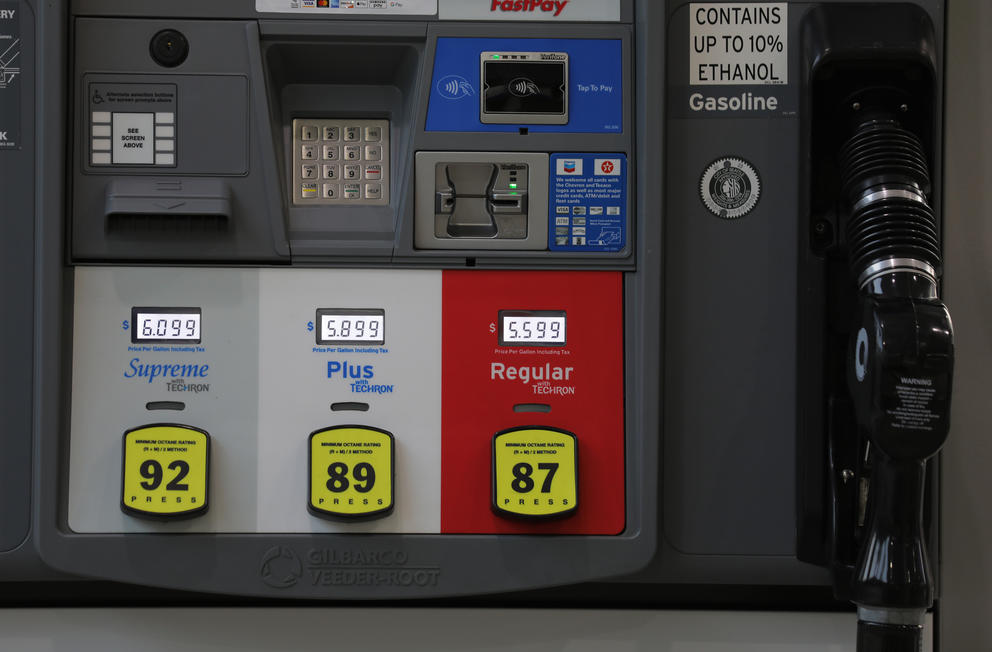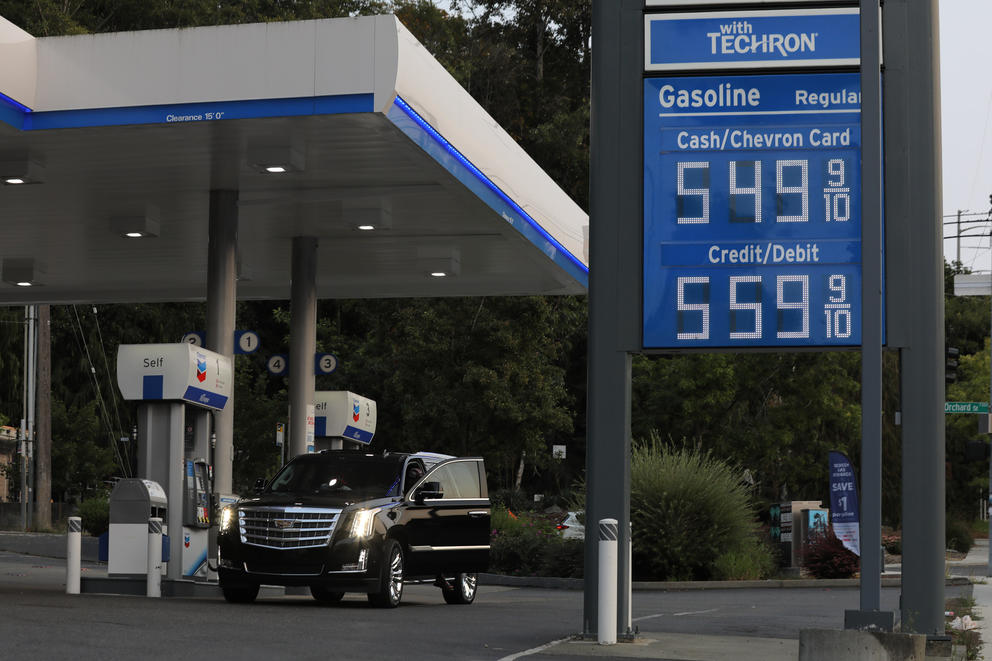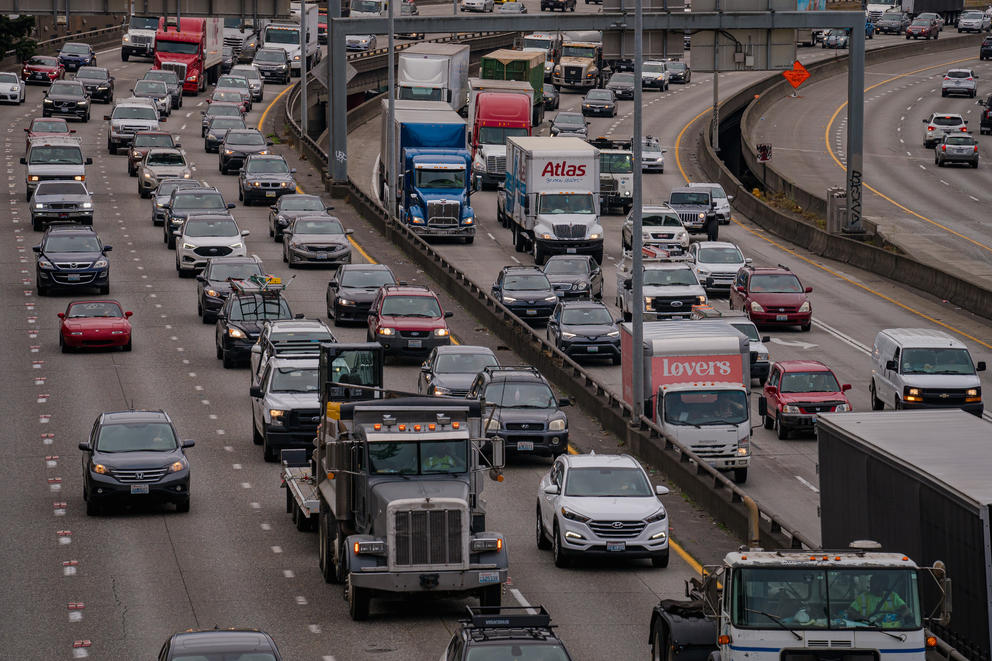Gov. Jay Inslee and Democratic leaders believe oil companies are not playing fair and may be increasing costs at the pump even if they don’t refine oil in Washington or participate in the state’s new carbon pricing system. These political leaders have recently announced plans to pursue legislation next year to require oil companies to open their finances to state scrutiny. Meanwhile, the program’s critics have started a statewide initiative petition drive to repeal it.
This political war erupted in June when Washington, for the first time, posted the highest gasoline prices in the nation, almost six months after the state’s second-in-the-nation carbon pricing system went into effect.
The reasons behind Washington’s high gas prices are a lot more complicated than just being a side effect of the new cap-and-invest program. Gas prices here have been among the highest in the nation for years, and prices at the pump fluctuate due to a variety of factors, including geopolitical events and even maintenance work at the state’s refineries, according to Inslee spokeswoman Jaime Smith.
The new cap-and-invest plan has been linked by some to an increase of 40 to 50 cents per gallon, but the state calculates the new program has led to a 26-cent-a-gallon increase. Since the participation of Washington’s oil refineries in the carbon pricing program is kept secret, it is nearly impossible to publicly analyze whether those links are strong or weak.
The new system, passed by the Legislature in 2021, is aimed at decreasing carbon emissions. A Washington Department of Ecology report measured the state’s carbon dioxide emissions at 99.57 million tons in 2018. A 2008 state law calls for overall emissions to be reduced to 50 million tons by 2030, to 27 million tons by 2040 and to 5 million tons by 2050.
But the immediate impacts are more varied. For one, the state government is raising a huge amount of money — roughly $1.28 billion so far in its first year — which the Legislature is allocating toward clean energy development and programs that mitigate the impacts of climate change, particularly on disadvantaged communities. This is the “invest” part of the new program.
Washington’s cap-and-invest program is the second in the U.S. after California’s system, which conducted its first carbon auction in November 2012, selling at a bid price of $10 per allowance, according to the U.S. Energy Information Administration. Final bids gradually grew to $36.14 per allowance by this summer. In 2014, Quebec joined California in putting a price on carbon.
Now Washington is thinking about joining a California/Quebec coalition to spread the costs to consumers by shrinking bid prices over a bigger market. The earliest that a Washington/California/Quebec market could go into effect would be 2025.
Jessica Spiegel, Northwest regional director for the Western States Petroleum Association, said one reason that California’s bid prices have been lower than Washington’s is that the Evergreen State’s carbon-reduction law trims those emissions at a steeper rate than the Sunshine State, creating greater pressure on carbon auction prices.
In Washington, carbon-emitting corporations bid every three months on state allowances for the pollution emitted by their facilities. The winning bidders all pay the same price on these allowances after the auction. The “settlement” prices in the first few Washington auctions were $48.50 for roughly one metric ton of carbon for the first quarter of 2023; $56.01 for the second quarter; and $63.03 for the third.
Although Republicans believe these increases led to higher gas prices, officials in the Washington Ecology Department caution against any fast conclusions after less than a year with the new system.
“Because our program is still new, one potential explanation is that market participants are still getting their feet under them as they develop their compliance and decarbonization strategies,” wrote Claire Boyte-White, the Ecology Department’s policy relations manager, on cap-and-invest issues in an email to Crosscut.
Economic formulas have calculated that a settlement price of roughly $50 would translate to a 40-to-50-cents-per-gallon gas price increase. The oil industry has acknowledged it has routinely passed that extra 40 to 50 cents to consumers to account for its extra costs. The impact on gas prices has been greater than the Democrats’ promises in 2021 that cap-and-invest would add only “a few pennies” to the price of a gallon of gas.
“We are not surprised by that. It should have been on everyone’s minds,” said Kevin Slagle, a spokesman for the Western States Petroleum Association.
Economists agree that is standard business practice.
However, the fuel-cost tracking service GasBuddy showed that Oregon’s and Washington’s gas prices had been roughly the same from 2014 through 2022, before cap-and-invest. On Jan. 1, 2023, the average GasBuddy regular pump price was 10 cents higher in Washington than in Oregon, which doesn’t have a carbon pricing system. On Sept. 27, the difference was 36 cents. That translates to an increase of 26 cents per gallon that theoretically could be linked to cap-and-invest, said Ecology Department spokesman Andrew Wineke.
Worth noting: Those numbers represent an across-the-industry increase, including on gasoline sold by oil companies not participating in Washington’s cap-and-invest program.
A leading critic of the new program is the Seattle-based conservative think tank Washington Policy Center. “It’s a costly program by design,” said Todd Myers, the WPC’s environmental director. He argues cap-and-invest is actually a tax designed to support Inslee’s environmental political agenda. It also makes pump prices so expensive that people will shift to using electric vehicles — another Inslee push, he contended.
Inslee and his supporters do not argue these points. The program was designed in part to raise money for environmental projects, and the governor has not been shy about his drive to get Washingtonians to switch from gas-powered to electric vehicles.
In its 2021 session, the Washington Legislature set a target of 2030 theoretically to encourage all state residents to wean themselves from gas-powered vehicles. This is not a mandate but a goal, according to the legislation. In 2022, Inslee announced a mandate that no new gas-powered cars will be sold in Washington beginning in 2035. Used gas cars can still be sold after that date.
The private sector has jumped on that bandwagon, and the switch to electric vehicles has begun. Ecology’s Wineke notes that 17 percent of new-vehicle sales in 2023 have been electric vehicles, adding roughly 150,000 such cars and vans to Washington’s roads. Toyota and General Motors have announced intentions to manufacture solely electric vehicles by 2035.
Oil-industry mystery
Unfortunately, we don’t have the same clear data from the oil industry. Except for the state Ecology Department, no one knows how many allowances each oil company has bought — or even which ones have actually participated in the carbon auctions. The identities of who bought allowances and how many allowances each bidder bought are confidential.
“That information is not allowed to be disclosed on a per-company basis, to avoid manipulation of the market,” wrote Inslee spokesman Mike Faulk in an email to Crosscut.
Oil companies don’t want to provide clues to competitors that they might be financially weak or are moving aggressively on cap-and-trade allowances, or provide other such information about their long-term strategies, said Clark Williams-Derry, an energy finance analyst at the Institute for Energy Economics and Financial Analysis.
The state has listed seven oil corporations among the “eligible bidders”’ for the three quarterly auctions. An eligible bidder has submitted all the necessary documents and has the Ecology Department’s approval. But being an eligible bidder does not mean the company has actually made a bid.
Eligible bidders in all three quarterly auctions were ConocoPhillips, BP America. HF Sinclair, Marathon and Chevron. US Oil was an eligible bidder in two auctions, and Exxon was an eligible bidder in one. Numerous non-oil companies have also been eligible bidders, including power companies.
Washington has five oil refineries — ConocoPhillips in Ferndale, Marathon in Anacortes, HF Sinclair in Anacortes, US Oil in Tacoma and BP America in Cherry Point. None of those five responded to Crosscut’s requests for comment, and would not confirm whether they bid in any carbon auctions or may be buying allowances to resell at a profit later.
The Western States Petroleum Association does not track cap-and-invest information from its members because doing so would violate federal antitrust laws, said Jessica Spiegel, the Association’s northwest region senior director.
Oil-industry transparency
So when Democrats develop a 2024 oil-company-finances transparency bill, the current law on confidentiality on cap-and-invest buyers will likely prevent them from looking at key figures pertaining to cap-and-trade allowances. “I find that ironic,” said Rep. Mary Dye, R-Pomeroy, the ranking Republican on the House Energy and Environment Committee.
Washington is following California’s lead in wanting to open the financial records of the oil industry. California’s oil-company transparency law went into effect this past June, so it doesn’t have a track record to study yet. However, the new California Division of Petroleum Market Oversight issued its first oversight report on Sept. 27.
On July 20, Inslee and Democratic legislative leaders announced their intention to file bills in 2024 to make oil companies more transparent. “This will force them to open their books and, if we find price gouging, to rein it in,” Inslee said.
“We want radical transparency,” said Joe Nguyen, D-White Center, at the same news conference.
Later, Myers of the Washington Policy Center said: ”This is part of an effort to deflect blame from themselves.”
Inslee’s office unveiled figures that show that Shell’s profits increased from $3.2 billion to $9.6 billion from the first quarter of 2021 to the first quarter of 2023. Exxon Mobil’s profits grew from $2.7 billion to $11.4 billion, and Chevron’s jumped from $1.4 billion to $6.6 billion. That equals a roughly $20 billion increase in profits over two years for three corporations serving Washington, while owning only one of the state’s five refineries.
“They are not just passing [the cap-and-trade costs] on, they are padding their profits,” Inslee said. In an interview, Kelly Hall, Washington state director for the liberal think tank Climate Solutions, said it’s important to know how the oil industry sets its prices. “Because profit margins are so high, they have flexibility to set the price.”
In an email to Crosscut, Williams-Derry said, “It’s hard for me to distinguish ‘price gouging’ from the ordinary workings of commodities markets. The whole point of commodities markets is … to squeeze as much money as possible from consumers. It’s built into the DNA of the market: Buy low, sell high. Buy oil as cheap as you can, sell refined products for as much as the market will bear. Also, markets are also inherently volatile and unpredictable.”
Details of the proposed oil transparency bill have not been addressed yet.
Rep. Beth Doglio, D-Olympia, a likely sponsor of the proposal, wants oil companies’ finances to be as transparent as those of utilities regulated by the state. But more research needs to be done on the nuts and bolts of such a bill, she said.
Williams-Derry of the Institute for Energy Economics and Financial Analysis suggests that an oil transparency bill should seek the costs of moving crude oil from the source to the gas pump, the costs of operating an oil refinery, capital costs including depreciation and the revenue that a refinery makes from selling to the racks.
The state needs a detailed grasp of the ownership structures of the oil industry serving Washington, said Leah Missik, senior policy manager for Climate Solutions.
But the Western States Petroleum Association believes Democratic leaders don’t have a good grasp on the complexity of what the proposed bill would seek. “Washington doesn’t know what it is getting into with this type of bill. … Thousands and tens of thousands of documents have to be collected,” said Slagle of Western States Petroleum.
“There can be many layers of middle players involved,” Western State’s Spiegel added.
While California installed its oil transparency bill this year, that state has some advantages over Washington in setting up such a venture, Slagle said. California has had its cap-and-trade law in place for 10 years, using that experience to set up the transparency system. Washington would have to build its transparency bureaucracy from scratch.
Oil-industry reality
California’s bill and the proposed Washington legislation come as questions arise about oil corporations’ commitments to dealing with carbon emissions.
“We’ve seen oil companies are actually pulling back on commitments to developing alternative fuels. Instead of directing excessive profits to reducing emissions and decreasing fossil fuel use, they’re prioritizing fossil fuels and more profits,” Faulk, the governor’s spokesman, wrote in an email.
A Sept. 14 Wall Street Journal story outlined how from 2006 to 2016 Exxon publicly declared support to combat carbon emissions while privately opposing those anti-carbon measures. On Sept. 19, California sued five oil companies in state court, alleging they had lied to the public about the climate risks of fossil fuels and seeking money to pay for recovery efforts from climate-change-related wildfires and storms, The Associated Press reported.
The basic economics of refining crude oil and getting gasoline to the pump are a constantly shifting kaleidoscope. “Things are moving every day, almost minute by minute. … Everything has different variables and different nuances,” said Denton Cinquegrana, an oil industry analyst for OPIS.
With five refineries, Washington has the fifth largest crude-oil-refining capacity in the nation at 650,000 barrels per day, according to the U.S. Energy Information Administration.
In 2020, 56 percent of the crude oil entering Washington came from Alaska. The costs of Alaska crude oil steadily increased this year, with those increases passed to the gas pump, according to the Alaska Department of Revenue.
Meanwhile, Washington’s “rack-to-retail” margins, the difference between the wholesale price and the retail price, are among the nation’s highest. Refined gasoline ends up in one of 27 wholesale clumps of tanks in Washington called “racks,” which are owned by the five refineries, other oil-related companies, and pipelines. ConocoPhillips owns five rack terminals in Washington; BP America, US Oil, Exxon and Shell own one each.
While they are not identical with profit margins, there is a strong correlation between rack-to-retail margins and profit margins, experts said.
Several reasons exist for the West Coast’s higher rack-to-retail margins. Cinquegrana noted that real estate costs — for gas stations, racks and refineries — are higher on the West Coast than in most of the United States, and those costs get passed to gas station customers.
The costs of transporting crude oil to refineries and refined gasoline from those facilities vary from state to state, with those costs being passed to customers. Tax systems also vary among states.
Coastal refinery-products markets tend to follow international trends more closely than do more landlocked markets in the central U.S., Williams-Derry said.
Here is a four-year look at Washington’s rack-to-retail margins, according to the Oil Information Price Service. Oregon and California posted similar figures for the past four years.
* July 2023, 69.1 cents per gallon, the second-highest in the nation.
* July 2022, 94.8 cents, fourth-highest.
* July 2021, 49.3 cents, third-highest.
* July 2020, 44.1 cents, third-highest.
The three Pacific Coast states consistently have had the nation’s highest rack-to-retail margins. Gas pump prices tend to follow those margins up or down. For example, the average price for regular gas in Washington was $5.555 per gallon in June 2022 when the rack-to-retail margin was much higher, compared to $5.084 per gallon in September when the rack-to-retail margin was 25.7 cents a gallon cheaper.
By contrast, Texas — full of oil fields and pipelines — has ranked 49th or 50th on rack-to-retail margins over the past four years, and Texas gas prices are also lower than those on the West Coast, according to OPIS.
California’s new Division of Petroleum Market Oversight’s first analysis of recent factors affecting that state’s gas prices notes the state’s gas prices increased 52 cents in the past month due to global market fluctuations; to refineries’ failure to store adequate reserves to handle unplanned maintenance outages that cut the supply of gasoline; and to an unusual spot trade in the oil trading market.
The “invest” part of the program
“Todd Myers — all he talks about is costs. It’s also about assets,” said former state Sen. Reuven Carlyle, D-Seattle, an advocate of the cap-and-invest program. Carlyle sees the program as an economic boon to Washington and a model for other states.
Washington’s leaders — and environmental scientists — have linked global warming to increased wildfires, more acidic sea waters off the state’s coast, problems with the state’s shellfish industry, a lack of water for farming, other troubles with the state’s crops, numerous health problems including asthma in children and other troubles. “People are feeling the impact of climate change now,” Carlyle said.
Last April the Washington Legislature divvied up the $300 million earned in the first quarterly auction into 188 appropriations for the 2023-2024 fiscal year.
These include intermingling solar projects with farm lands, adding climate change to urban growth planning, climate change projects for the state’s tribes, capturing methane from landfills, installing solar panels on nonpublic buildings, dealing with child asthma in the SeaTac area, building infrastructure for electric vehicles, building a hybrid fuel/electric ferry and overhauling ferry docks and terminals to handle electric ferries.
Overall, Washington is on track to raise roughly $1.7 billion to $2 billion in 2023 for projects designed to address the harmful effects of climate change. The governor’s annual budget proposal will be unveiled in December — the first public indication of where the bulk of the cap-and-invest revenue might go.
Where we stand on carbon
Washington is ahead of its goal on trimming carbon emissions, according to the think tank Rocky Mountain Institute. The Institute is using a different timetable than the 2021 Ecology Department report used. Instead of starting the countdown in 2018 as the state did, the Rocky Mountain institute began its countdown in 2005. Under the Institute’s countdown, the state’s goal was to trim Washington’s carbon emissions by 25 percent by 2030, and it is on track to trim by 28 percent by 2030, the think tank calculated.
Washington needs to trim its carbon emissions to 50 million tons by 2030 in order to hit its 5-million-ton target by 2050. “That trajectory to 2050 is extremely dependent on 2030,” Carlyle said.
The Washington Policy Center has led the Republican attack on Inslee over the link between the state’s high gas prices and the cap-and-invest program.
That irritates Carlyle because the think tank’s annual report lists the WSPA, ConocoPhillips and Marathon as financial donors. “[Myers] is funded by the exact entities that are the subject of his data. This is being heralded as neutral objective data,” Carlyle said.
Myers, Spiegel and Slagle said the WSPA’s financial support of the Washington Policy Center is a normal practice among businesses and special interests on many issues that think tanks study.
The WSPA also belongs to Affordable Fuel Washington, a coalition opposing the cap-and-invest program, but they claim their stand on this issue is nuanced. “We’re not in opposition to the Climate Commitment Act [which set up the cap-and-invest program]. We’re trying to fix it,” Spiegel said.
Myers countered Carlyle’s criticism by saying Carlyle is on the board of directors of the environmental organization Clean & Prosperous Washington and is the founder of Earth Finance, a consulting firm for corporations seeking to cut carbon footprints while remaining profitable. Myers also noted that Tom Wolf, West Coast senior government affairs manager for BP America, is also on Clean & Prosperous’ Washington’s board.
“He [Carlyle] and his allies are making money off of it. Why shouldn’t I accuse him of ulterior motives?” Myers said.
Carlyle spent 14 years in the Washington Legislature before retiring last year to found Earth Finance. During his stint in the Legislature, he was a hardcore budget wonk passionate about environmental issues, sometimes clashing with the late Sen. Doug Erickson, R-Ferndale, a climate change denier with significant donations from the oil industry. Carlyle said Earth Finance is focusing on nationwide and global clients instead of seeking customers in Washington.
BP America belonged to the Western States Petroleum Association until 2020, when it decided to resign its membership because of major differences on carbon pricing. In 2019, BP America reviewed whether its goals are compatible with those of the 30 trade associations it belonged to. That review concluded that the WSPA and two others did not share its philosophies on carbon pricing, anti-carbon technology, its support of the 2015 Paris global climate accords, and other climate change issues.
“My hope is that in the coming years we can add climate to the long list of areas where, as an industry, we work together for a greater good,” said BP America CEO Bernard Looney in a 2020 press release.
“I think they see the writing on the wall,” Hall said.









